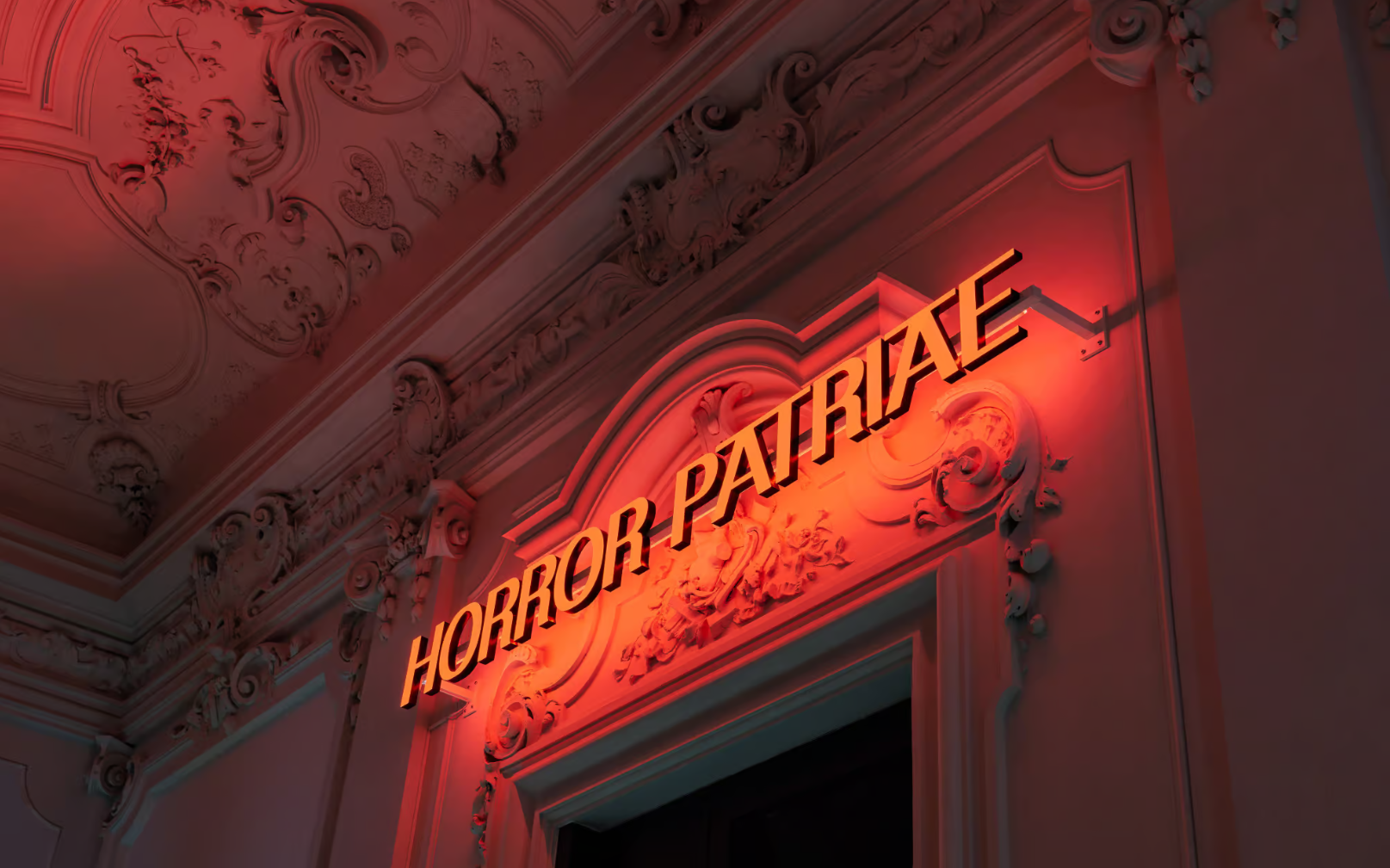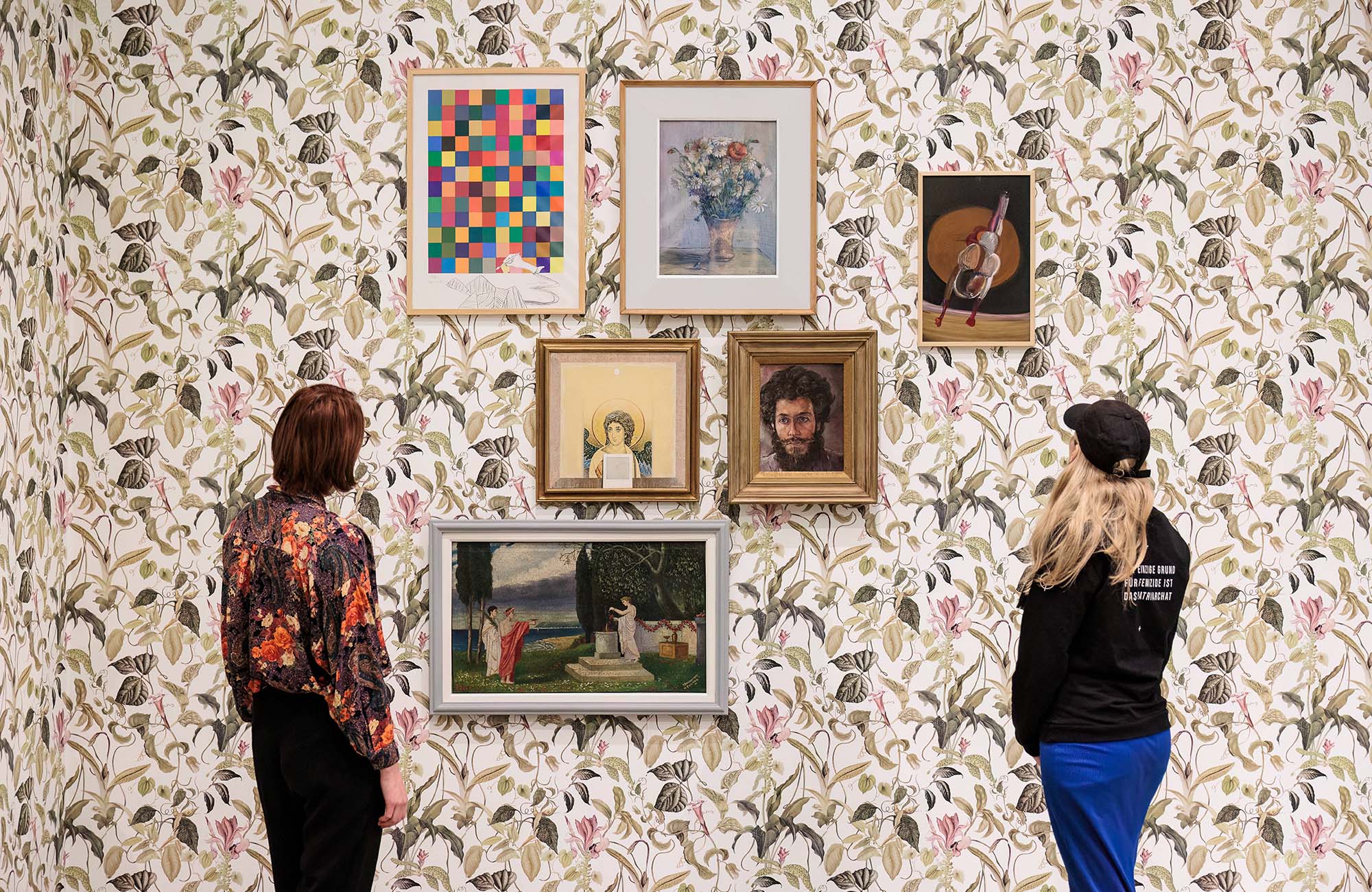
No Feeling Is Final
The Exhibition about the Skopje Solidarity Collection in Vienna
It is not a big surprise that Ivet Ćurlin, Nataša Ilić, and Sabina Sabolović, the well-known curators of the acknowledged curatorial collective WHW, mostly known as What, How & for Whom again chose a political topic within the frame of a group show. This international collaboration demonstrates the collective’s commitment to the post-Soviet region from where they originate, as is known of the collective, which was formed in 1999 and is based now in Zagreb, Croatia. And rightly so, as 42% of the city’s population has an immigrant background (more than half of the population of Vienna are immigrants), many of whom come from the Balkans. To make the picture even more complete, the WHW worked with the Solidarity Collection on the exhibition No Feeling Is Final, which is the collection of the Museum of Contemporary Art Skopje, North Macedonia (MoCA), located in former Yugoslavia.
On July 26, 1963, Skopje suffered a devastating earthquake, but thanks to world media, images of the tragedy of the city were broadcasted all around the world. The shocking media coverage of the earthquake’s survivors inspired donations from the United Nations to help their recovery. As a part of this process, a lot of valuable artworks were sent from highly celebrated international artists of the Western art world, as well as from Belarus, South Africa, Chile, and New Zealand, to mention a few. Thus, a unique art collection was formed and named the Solidarity Collection, emerging from a tragic event that shook the city and aiming to create a new perspective on solidarity and society, as well as the well-rehearsed history of modern art in Western capitals. The collection validates itself in the sphere of culture, regardless of market relations, or national representation.
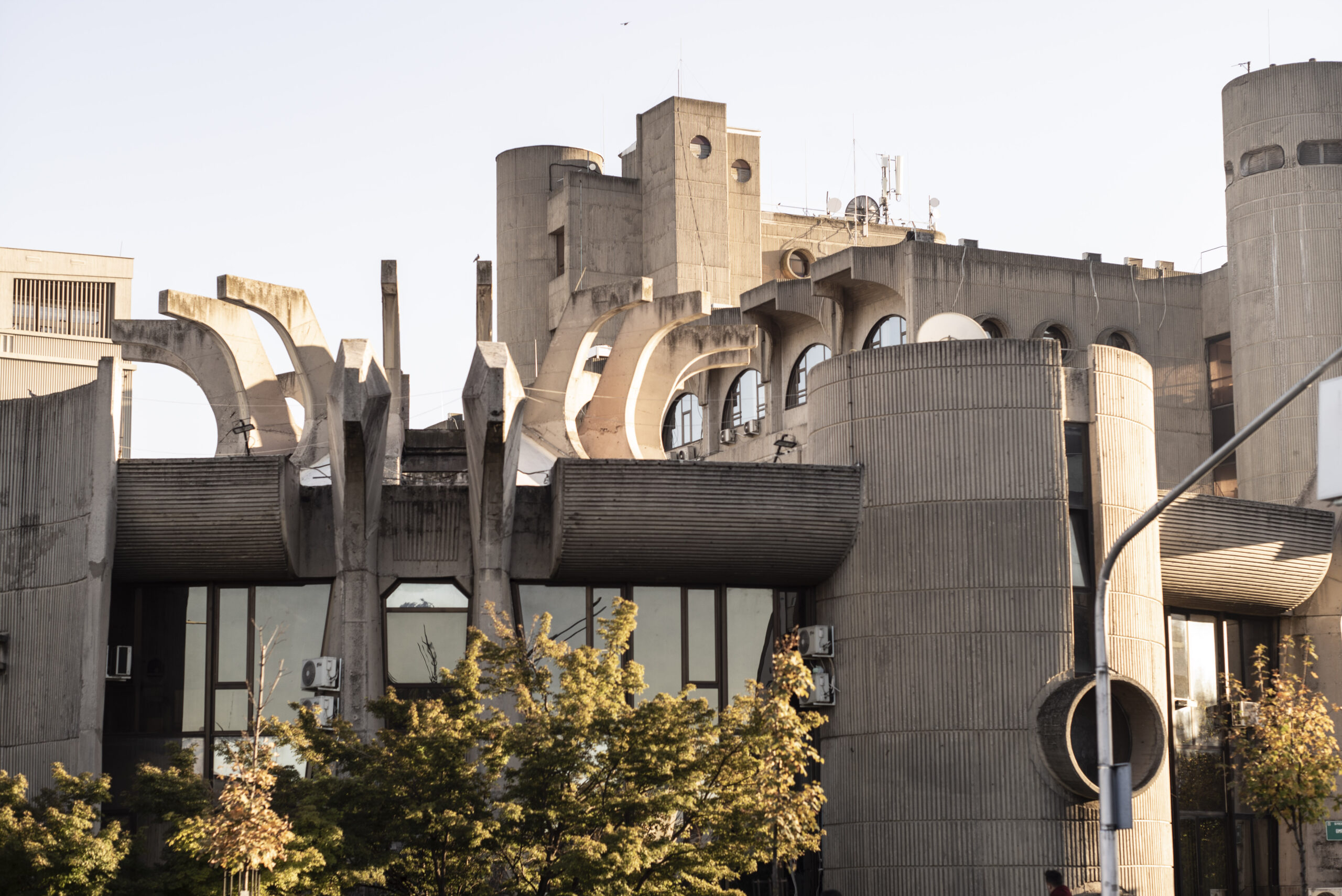
As a second layer, we can take a closer look at the history of Skopje and the extensive section on the rebuilding of the city. Elfie Semotan’s “No Feeling is Final” series not only provide the title of the exhibition but also emphasizes the unique character of the multi-layered city of Skopje and the museum’s building complex. Her images are not just portraying Skopje’s cultural diversity — from the Ottoman Old Bazaar, to the modernist rebuilding of the city after the 1963 earthquake, but following the history of the city’s architecture: mentioning the project to remake Skopje as a Classicist city, as well the controversial Skopje2014 project. In her photo series, she gives a closer look of the iconic modernist buildings, such as the National Opera and Ballet, the railway station by Kenzō Tange, the Museum of the Republic of Macedonia by Mimoza Nesterova-Tomić, the iconic Telecommunication Center’s main Counter Hall (which burned down in a suspicious fire in 2013), and, of course, the Museum of Contemporary Art Skopje.
Apart from showing selected pieces from the collection, the curatorial collective invited several contemporary artists, just like Elfie Semotan to contribute with their own artworks and to react to selected works from the collection, thus transferring the exhibition to a more contemporary level by expressing their own visions. Brook Andrew (Melbourne), Yane Calovski & Hristina lvanoska (Skopje), Siniša Ilić (Belgrade), Iman lssa (Berlin), Gülsün Karamustafa (Istanbul), and Barbi Marković (Vienna) also react to the history of Skopje and the museum’s Solidarity Collection with its historical and cultural heritage, but more importantly, they demonstrate a critical voice between the present and the past, highlighting how current events, such as the earthquake of Turkey or the war in Ukraine, are still ongoing problems.
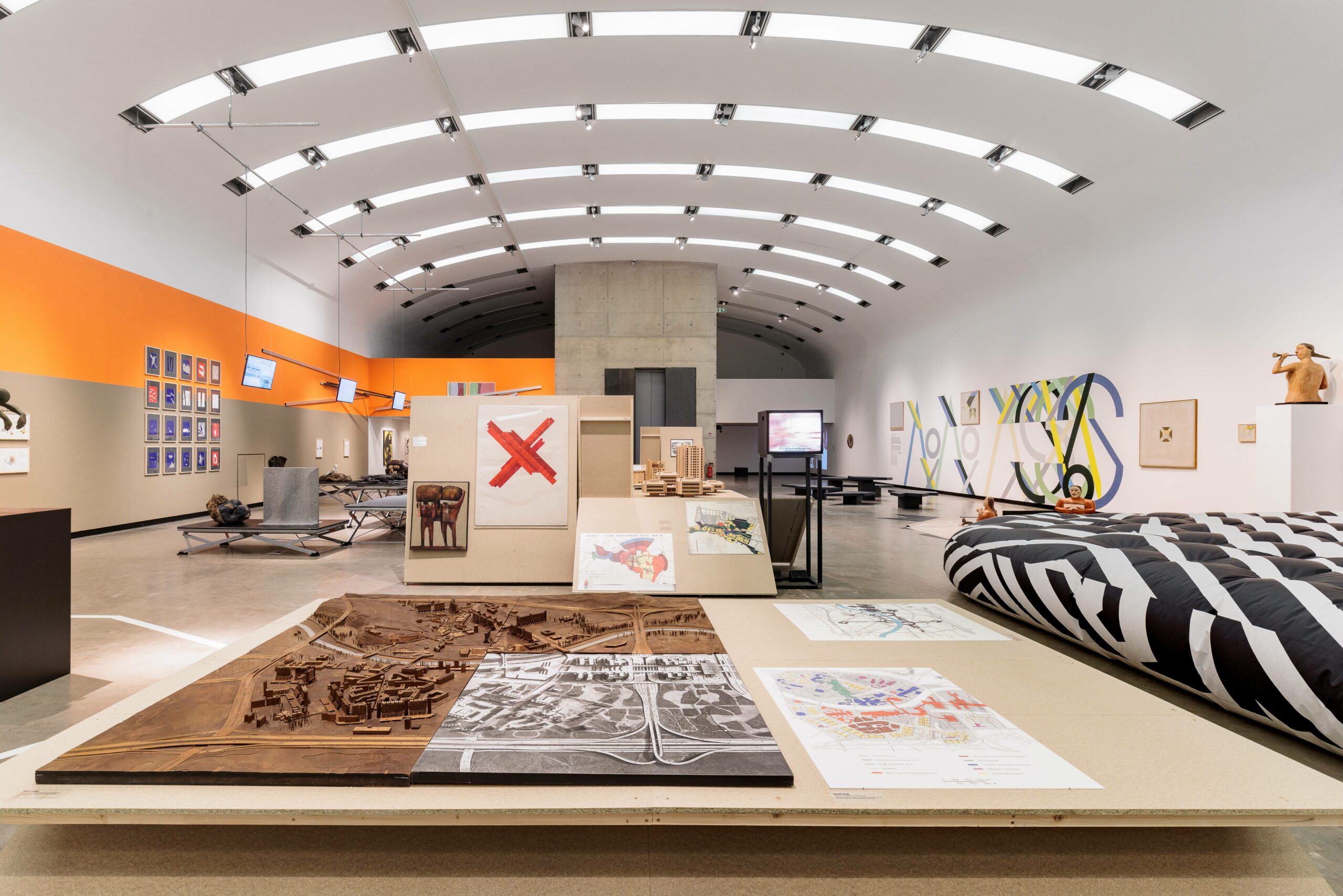
What makes an exhibition about a collection so relevant and worth attending is the curatorial ability to show how a specific collection can reorient us to look at the issues of the past and the present, how we can rethink the term solidarity, and how the conditions in which the collection was assembled are still significant today in our fast-changing world. Before you go and visit this exhibition at Kunsthalle Wien, just take a moment – close your eyes and imagine an exhibition that was built as a large-scale gesture of international solidarity in the wake of the earthquake that hit Skopje in 1963. In addition, documents of historical monuments and the earthquake provide a diverse picture of the historic event.
Thousands of artworks that were donated to this new collection of MoCA by artists from around the world now stand in front of us, creating a new dialogue with contemporary artworks. In collaboration with MoCA, the curatorial team invited six artists to engage with the Solidarity Collection, a gesture that led to a sort of re-enactment of the past.
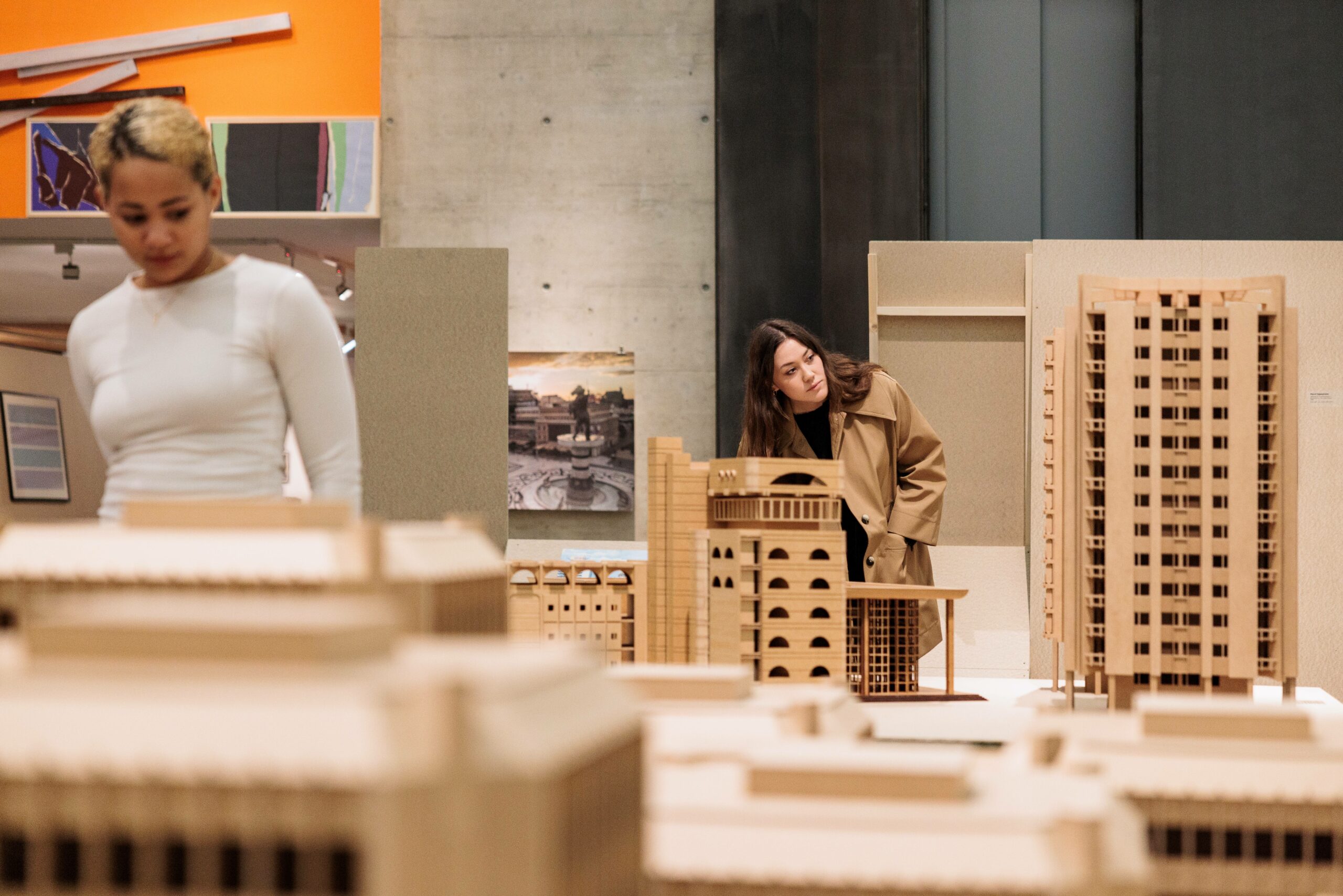
The museum’s building was constructed with the help of the Polish Aid for Skopje Program in 1965. Poland was very invested in helping Skopje by sharing its own experience of rebuilding after the Second World War, as well as forming a collection like this, since for example, the architect (Oscar Hansen) who designed the museum building was also Polish.
The Austrian photographer, Elfie Semotan, and the Serbian Vienna-based fiction writer, Barbi Marković, created a visual and written commentary on the preparatory path that led to the collection’s arrival in Vienna. In the spring of 2024, the exhibition will travel to the National Gallery of Prague and then return to its original location at the end of next year. The Czech Republic is an important place as there are a lot of local artists (around 250) who offered their artworks to the collection. The exhibition also deals with what is lost when one’s whole environment collapses into pieces, but also with how the structure of one’s living environment can be rebuilt with solidarity.
What is unique about the MoCA Solidarity Collection is that it can be seen as a collection of the international trends of Modernism in the late sixties. In the 60s, Modernism was still in its prime and provided a platform for rare artistic encounters across the Cold War divide, between the East and the West. Furthermore, the collection involved artists from the Eastern Block, as well as from the Global South, which was also influenced by the Fluxus movement and the Neo Avant-Garde. Considering that the Global South also played an important role in Modernism, unusual perspectives form as we are standing in the Kunsthalle, not so far away from the Weltmuseum Wien.[1] The questions of restitution and heritage are brought to the surface even as we speak of the Solidarity Collection because some artifacts from new interventions connect artists of third-world countries with Western ones. Unlike the collections of most Western museums, the Solidarity Collection did not come into being from expropriated artworks and objects, but as the result of a long process of donation.
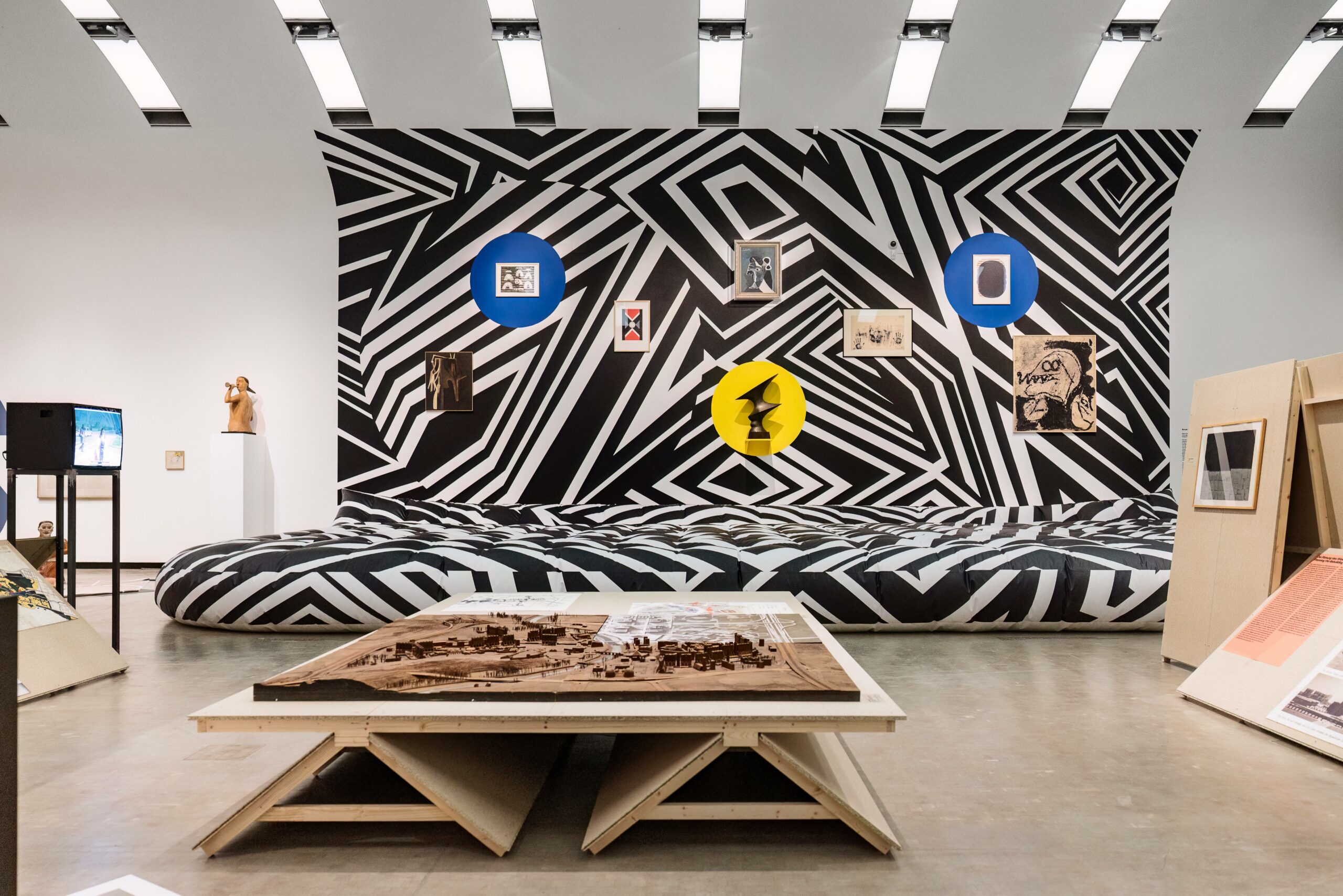
What was particularly interesting in this exhibition, was that while each invited artist created a new constellation in an exhibition format, they preserved something of the original works of the Solidarity Collection, or at least referred to them. The curator and artist Brook Andrew (Melbourne) created an installation that functions more as a playground: it stands at the center of the exhibition space, which with black and white strips and its enormous size, is always in the spotlight. The title of the work mulunma wiling mangi gudhi (inside the lip of a stolen song) commented on the complex relationship between appropriation and theft, which is reflected in almost any dominant artistic approach that deals with the topic of restitution.
What is unique in Andrew’s artwork, is that he creates a contradiction by placing key modernist works from MoCA’s collection while he appropriates the title from the Wiradjuri language (aboriginal language) and also uses patterns from the Other (the underrepresented people and culture of the Third World). The installation includes works such as The Last Draught (1963) by one of the artists from the CoBrA group, Pierre Alechinsky; the well-known masterpiece Woman’s Head (1963) by Picasso; the monochrome Countrywomen (1956) by Zoran Mušič; a sculpture called Big Anvil byOtto Logo(1964); a print of the artist’s body parts Skin with O’Hara Poem (1963) by Jasper Jones; the painting with Afro-Cuban aesthetics Four Hands for One Being (1965) by Alfredo Lam; and the geometrical, almost constructivist Black Mass (1964) by Kumi Sugani. It also features artworks from Balkan-born artists, for example: Marjan Vojska’s Print X (1988) or the Small Painting 4 (1964) by Vladimir Veličković inspired by Wiradjuri and Celtic ancestry, whose research aims to build forms and kinship between non-Western and Western cultures and the intersectional notion of identity. Brook Andrew used the same concept he applied in his 2017 installation at the Van Abbemuseum.
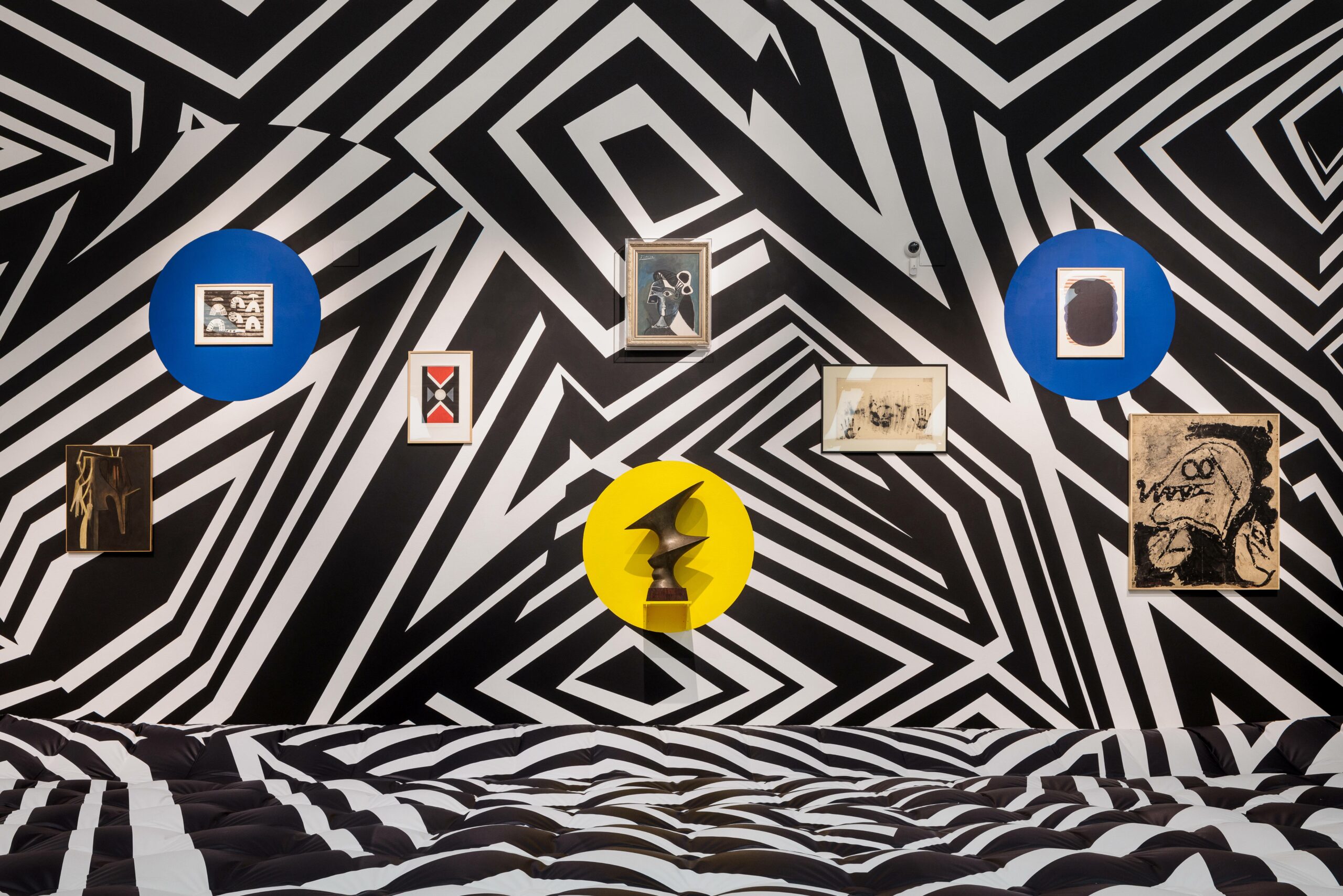
Andrew Brook often creates interventions in museum displays criticizing its collection policy, highlighting the connections between colonialism and cultural dispossession, and establishing a sharp contrast by utilizing indigenous practices, and anti-colonial power, which offer a completely different structure from linear Western patriarchist art history canon. The problem with Andrew’s installation is that there is too much emphasis on the consumerist culture (which also can be a reference to the visitor’s consumerist culture) as it also offers a way to entertain themselves in a huge soft black and white bouncy castle. All in all, it modifies the tone of the whole exhibition, which is highly research-based. The act of appropriation would be more provocative if he did not only limit himself to the well-known black-and-white patterns of the Aboriginal Australian people from Central New South Wales (the Wiradjuri people), who are united by common descent through kinship and shared traditions. It is worth considering the fact that the exhibition is located in Austria’s capital city and that the restitution procedures are still ongoing, especially regarding the Weltmuseum.[2] Andrews’ work is not at all unfounded, although he uses the same concept that we have already seen at the Van Abbemuseum.
The MoCA was established in 1964, and the first art historian of the institution was Boris Petkovski. He was actively involved in the founding of the museum, as he thought it could become a perfect example of bringing Eastern and Western narratives together. The famous Polish architect and art educator Oscar Hansen’s Open Form Theory also played a huge role in creating the interior of the museum.[3] Hansen imagined an exhibition space made of six-sided elements with hydraulic lifting devices, which enable the curators to change the display freely. For the exhibition format at Kunsthalle, Yane Calovski and Histrina Ivanovska have created a speculative re-enactment of Oscar Hansen’s ideas called All Things Flowing (2023), to rethink the original concept of the Open Form, which was applied for Skopje’s Museum of Contemporary Art and is able to open up entirely and close again thanks to its moveable structures.
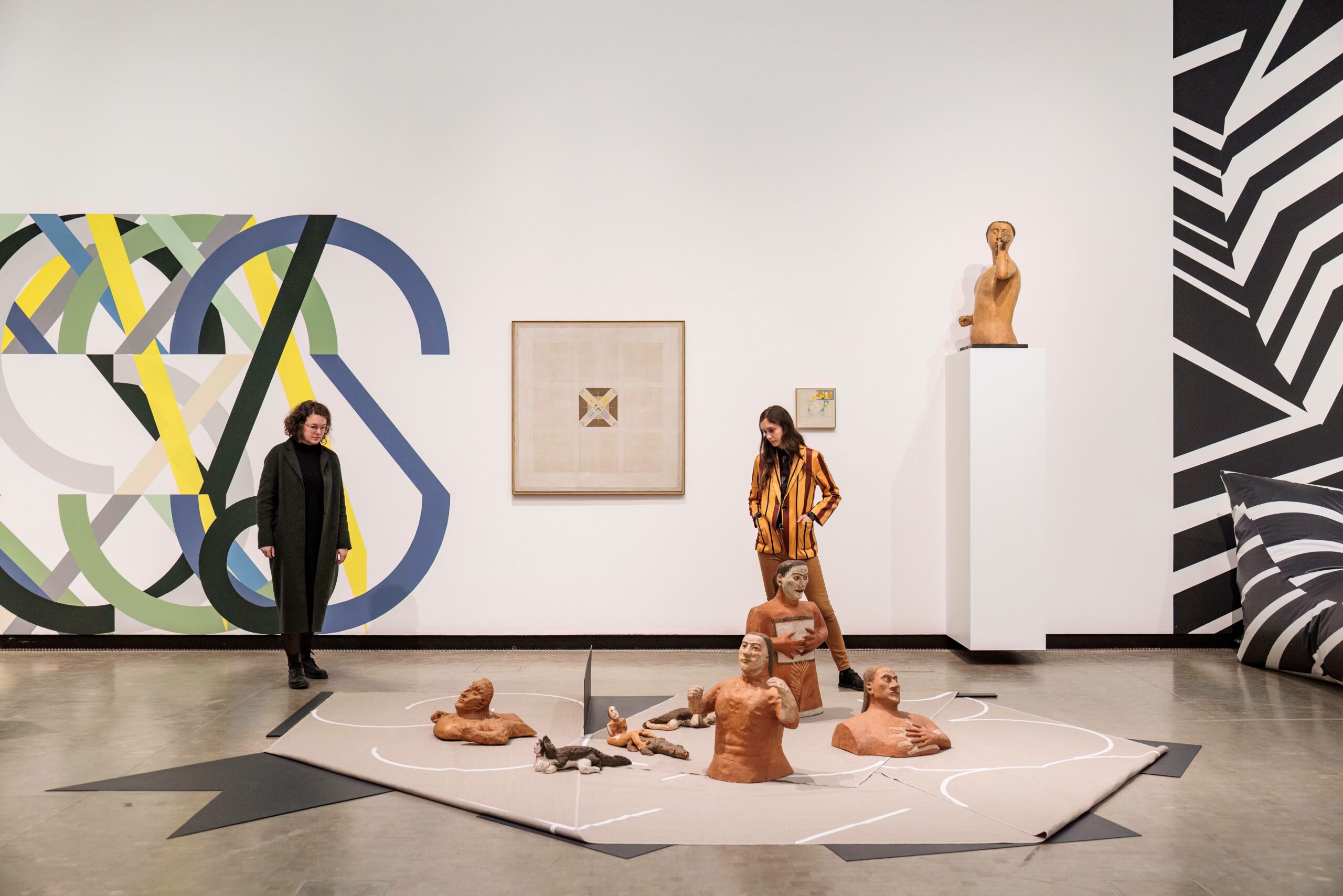
The work of Siniša Ilić links our conflicting times with the consequences of historical moments and their representations showing the patterns of traumatic experiences of citizens, proposing a recontextualization of the city of Skopje in a spatial installation titled Filigran (2022/2023). While he involves the audience to have a first-hand experience, he shows eight pictures of the collection with his drawings, which underlines the exceptional connections between post-earthquake ruin and modernity.
Iman Issa examines through her artistic work how the curatorial and artistic praxis is determined by its white Western attitude, and how institutionalisation and curatorial discourse have impacted the collection itself as well. The concept of her work is “saving the works from appropriation by making the appropriation very transparent”. With the help of eight works from the collection, transparency, and hierarchy can be rewritten.
Gülsün Karamustafa focuses on a historical story of her home city Istanbul, the city which was called so many names throughout the centuries. In her work, titled Crime Scene (2022/2023), little ceramics and pottery objects are juxtaposed with works from the original collection. She is interested in cases where solidarity can work visibly, and where it cannot, which is why she creates ideal environments for her objects, placing them in family home settings.
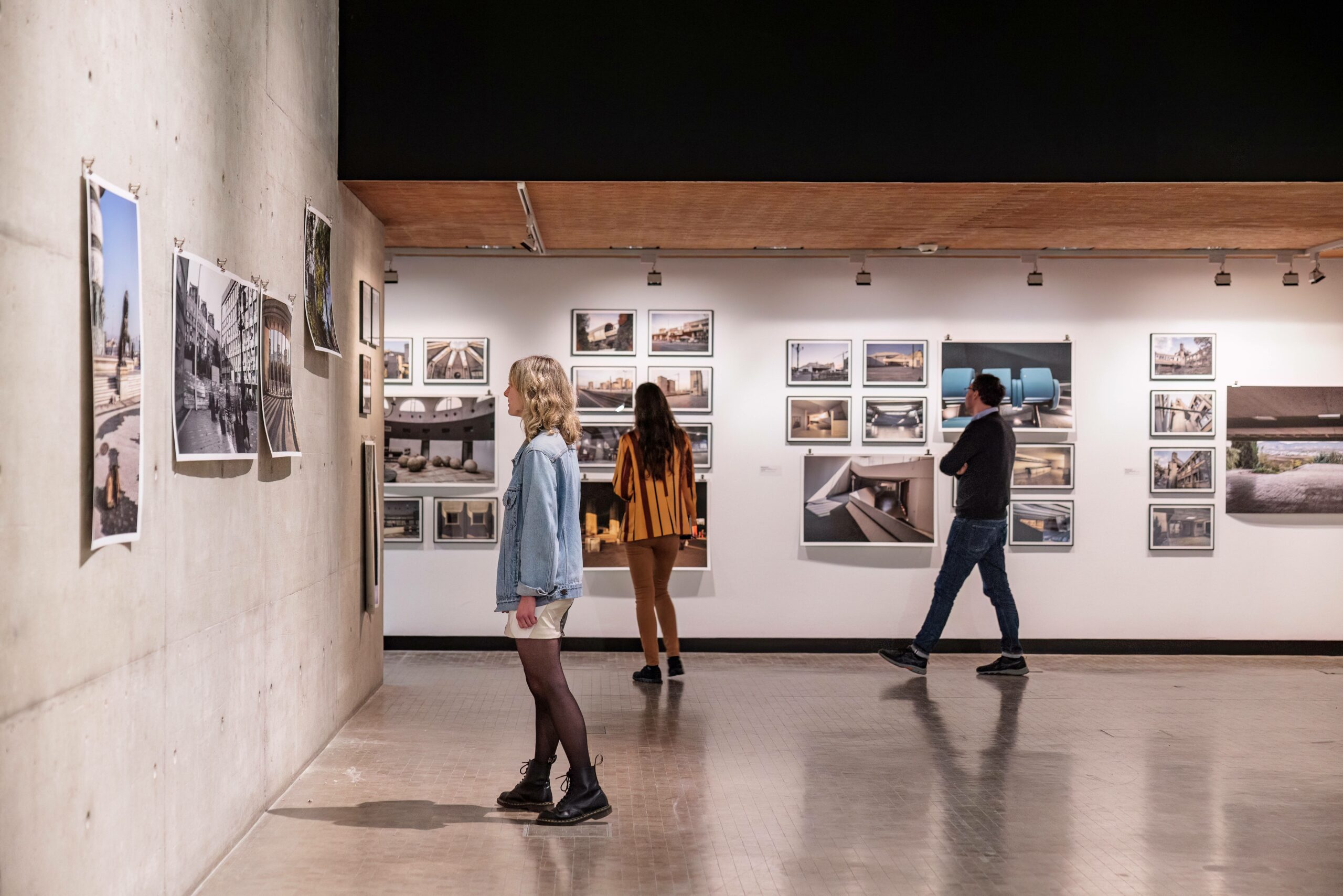
This exhibition is unique in its own way as it deals with time in various ways: there are different layers of historicity, artistic interventions, and an immersive approximation of architecture, with special regard to a Japanese architect, who focused on modular structures and living organisms in parallel with the Metabolism movement, and who got deeply involved in the reconstruction of Skopje. Kenzō Tange (1913-2005) was selected by the UN support program, and his architectural views shaped the city.
The exhibition also contextualizes and evokes the spirit of the place, not only connected to the earthquake and the subsequent rebuilding but also to 2014, when the city’s image was transformed thanks to the Skopje 2014 project, financed by the Macedonian government, which aimed to give the city a more classical appeal. With the purpose of strengthening the presence of the city’s history, the nationalist party not only constructed important museums and government buildings but also erected monuments depicting Macedonia’s historical figures.
The collection itself incorporates many layers of time, as it was not designed to be a classical curatorial or collecting project. The exhibition guidebook collects personal interviews with the artists and short texts about the story of the earthquake and the reconstruction of the city of Skopje as well as the founding of the museum collection, which brings us to the questions raised by the artists and that the exhibition poses to its visitors: what do you think about solidarity? Do you think a collection like the Skopje one could ever be created again with thousands of artists offering their artworks? How can we examine an exhibition like that at a time when instability across Europe is tangibly present? These questions raise new thoughts worthy of thinking about even after leaving the exhibition space.
[1] The Weltmuseum Wien in Vienna is the largest anthropological museum in Austria, established in 1876. It holds a collection of more than 400,000 ethnographical and archaeological objects from Asia, Africa, Oceania, and America.
[2] “In 1998, on the basis of the Art Restitution Act passed in the same year, provenance research also began in the Weltmuseum Wien (then the Museum of Ethnology). It is about the systematic examination of the stocks that have come into the house since 1933. Among other things, the origin of more than 63,000 objects or inventory numbers is examined, whereby an inventory number often consists of several individual objects. Dossiers are created for all dubious acquisitions. These dossiers are handed over to the Commission for Provenance Research based in the Federal Monuments Office and from there to the Art Restitution Advisory Board of the Federal Ministry for Education, Art and Culture, which advises the responsible minister in the decision regarding a possible return to the original owners or their legal successors. Research is not only carried out in the archive of the Weltmuseum Wien, but also in a number of external archives at home and abroad. The research is carried out in cooperation with the Commission for Provenance Research.” – from the website of Welt Museum.
[3] Polish art educator and architect Oscar Hansen’s Open-Form project. As a professor at the Academy of Fine Arts in Warsaw (now Akademia Sztuk Pięknych), Hansen thought about open systems and utopian spaces both as an architect and as a teacher, and carried out pedagogical exercises with his students that were in line with Neo Avant-Garde and Fluxus trends.


